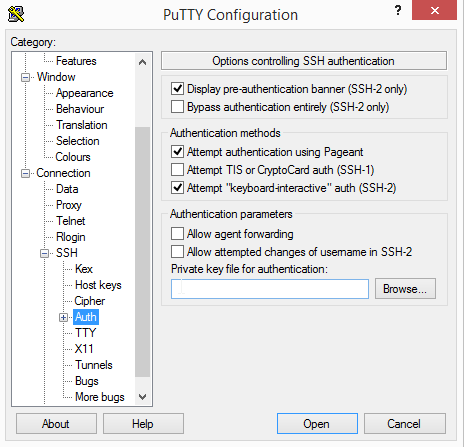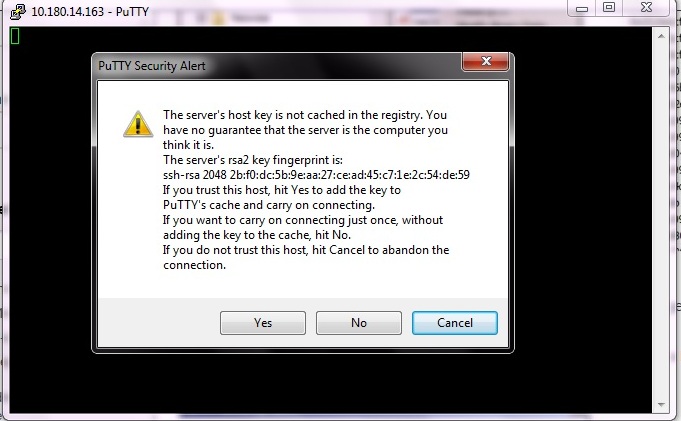

- #PUTTY SSH WITH KEY HOW TO#
- #PUTTY SSH WITH KEY 64 BITS#
- #PUTTY SSH WITH KEY SOFTWARE#
- #PUTTY SSH WITH KEY PASSWORD#
- #PUTTY SSH WITH KEY PC#

Step 4 - Copy public key to your server Option 1: Copy key over FTP Copy on your clipboard the content of the field "Public key for pasting into OpenSSH authorized_keys file.
#PUTTY SSH WITH KEY PC#
Save your public/private keys safely on your PC using the buttons "Save public key" / "Save private key".Note: This passphrase will be requested every time you try to connect using the generated SSH key. RECOMMENDED: Enter a "Key Passphrase" to protect your ssh key.Change the "Key comment" field to name your key to a meaningful name like: "home", "office", "home-pc-i7", etc.Move your mouse around on the blank space to randomize your key.Step 2 - Run PuTTYgenĭouble-click on the executable just downloaded.
#PUTTY SSH WITH KEY 64 BITS#
If you don't have PuTTY installed on your PC just download puttygen.exe (select 32 / 64 bits version according your PC, most probably 64-bit).
#PUTTY SSH WITH KEY HOW TO#
With Cygwin running now with the loaded private keys from Pageant, you will be able to make secure, automated SSH connections from this shell to remote environments or other services built on top of SSH, like SFTP file transfers or pushing to git repositories.This tutorial will guide you on how to create an SSH key using PuTTYgen in your Windows PC and how to copy this key to connect to your server. # ssh-pageantĮval $(/usr/bin/ssh-pageant -r -a "/tmp/.ssh-pageant-$USERNAME") By editing your ~/.bashrc (or ~/.bash_profile - check where Cygwin is installed on your computer for these files) to add the following, this program will run whenever you start Cygwin. The last step is to download this daemon that allows you to use your loaded SSH keys from PuTTY’s Pageant in Cygwin. The simplest way to do this in Windows is to create a specially crafted shortcut inside the Startup folder (Start -> Programs -> Startup). Pageant can load one or more private keys when it starts up if you provide them on the Pageant command line.

You can manually load them each time through this UI when your computer boots up, but the more efficient approach is to have them load on startup following these steps. ssh/authorized_keysĮnsure that PuTTY’s Pageant (downloaded in Step 1) is running (you should see a little icon for it in the tray at the bottom of your screen):ĭouble-click this to see the current list of private keys loaded to Pageant. Then change its permission to 644 with this command: $ chmod 644. Save and exit Nano by hitting ctrl+O, enter, then ctrl+X on your keyboard. sshĬopy the generated public key in PuttyGen and paste it in the Nano editor: In your home directory, issue the following commands: $ mkdir -p. You’ll need the standard username/password credentials for the instance for now. Open up Cygwin and log into the machine that you wish to configure with SSH keys. pub) extension and the private key with a. Make sure you save the public key with a. Keep PuTTYgen open for now as you will need to copy the public key value into the authorized_keys files on the appropriate private server.
#PUTTY SSH WITH KEY PASSWORD#
When saving the private key you will be optionally asked to enter a password for another layer of security if desired - it is also possible to hit ‘OK’ and not use a password in combination with the SSH private key. You can create this directory if it doesn’t exist. ssh folder of your home directory will be something like this: C:\Users\\*username*\\.ssh. Click the ‘Save public key’ and ‘Save private key’ buttons to save these to the same location as your other keys (if you have any). Using the downloaded PuTTYgen executable, generate a new key.
#PUTTY SSH WITH KEY SOFTWARE#
For this my team uses Cygwin, a Linux-like environment for Windows making it possible to port software running on POSIX systems (such as Linux, BSD, and Unix systems) to Windows. In my work at Digitas, I need to login to a number of client-specific Linux machines via a terminal emulator (there is no UI for these remote environments) from my local Windows laptop. Cygwin putty ssh windows SSH Keys With PuTTY and Cygwin for Windows


 0 kommentar(er)
0 kommentar(er)
